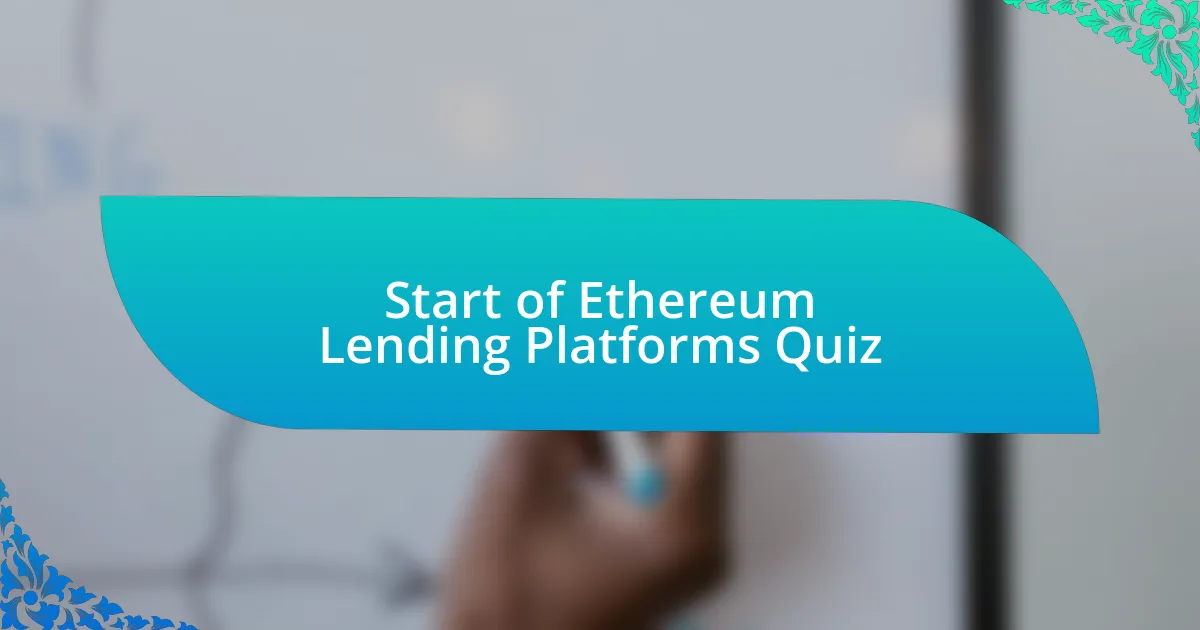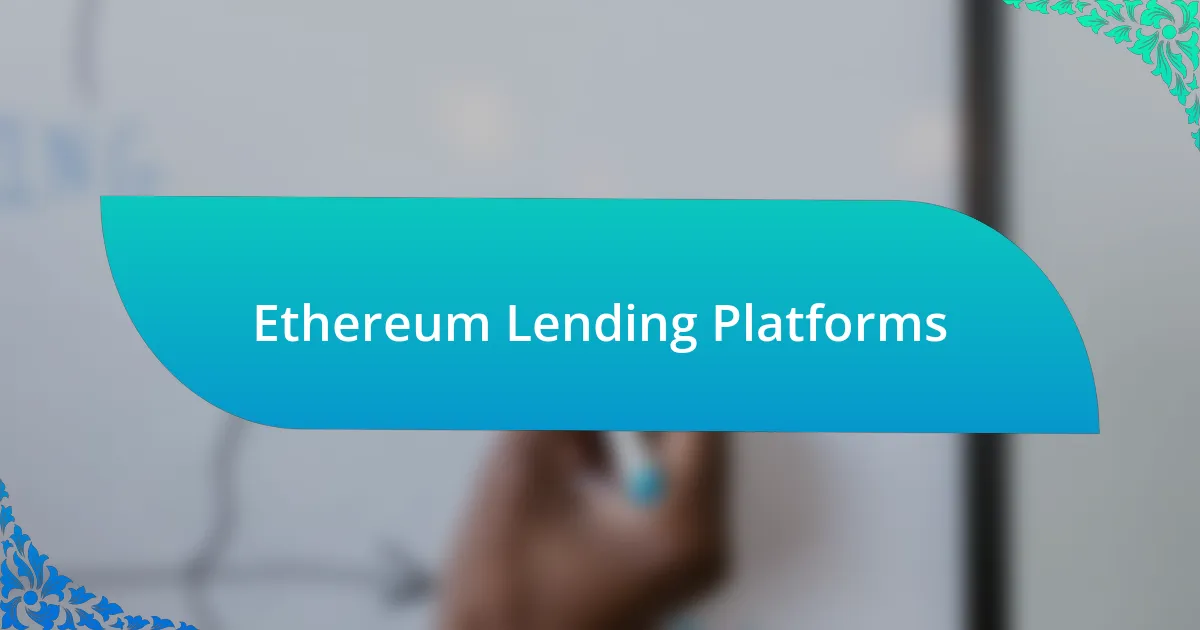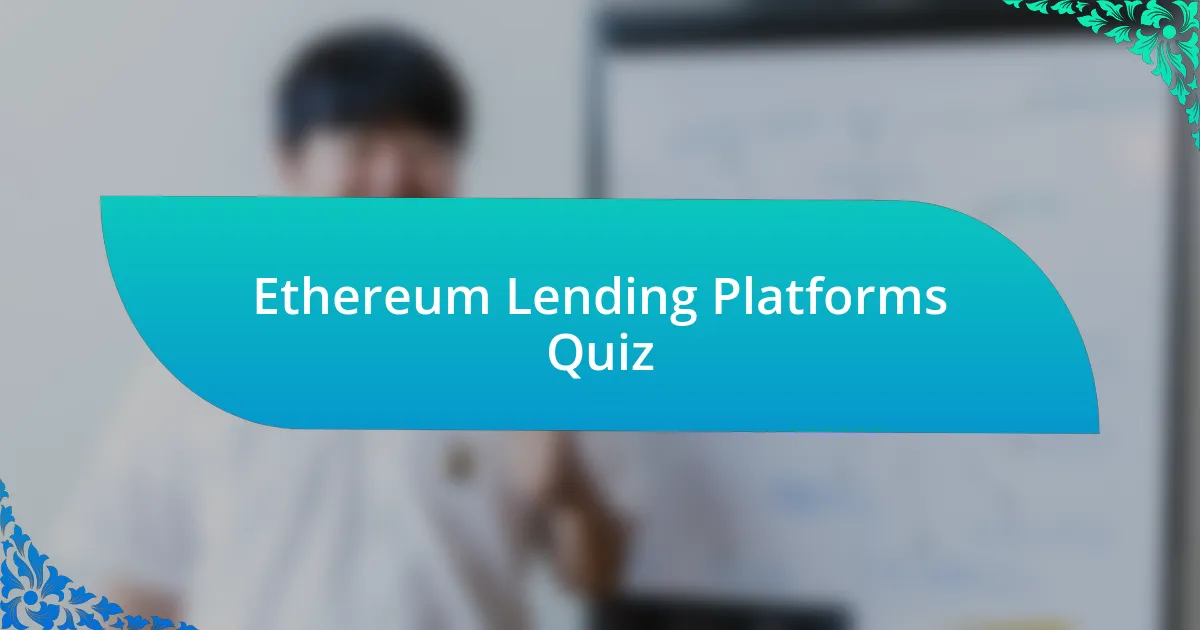
Start of Ethereum Lending Platforms Quiz
1. What is Ethereum?
- Ethereum is a hardware wallet specifically for Bitcoin storage.
- Ethereum is a type of cryptocurrency that can only be mined.
- Ethereum is a second-generation distributed ledger technology launched in 2015.
- Ethereum is a popular mobile payment app for transferring money.
2. What is Ether?
- Ether is a type of computer programming language.
- Ether is a blockchain mining hardware.
- Ether is a type of cryptocurrency wallet.
- Ether is a crypto-fuel that powers the Ethereum network.
3. Which consensus algorithm does Ethereum use?
- Proof-of-Work
- Delegated Proof-of-Stake
- Byzantine Fault Tolerance
- Proof-of-Stake
4. What are smart contracts?
- Smart contracts are written agreements on paper that require mailing for validation.
- Smart contracts are traditional contracts verified by notaries in person.
- Smart contracts are self-executing contracts with the terms of the agreement directly written into lines of code.
- Smart contracts are physical documents stored in legal offices with signatures.
5. What is MetaMask?
- MetaMask is an online bank for storing traditional currencies.
- MetaMask is a social media platform for sharing cryptocurrency news.
- MetaMask is a hardware device for mining Bitcoin.
- MetaMask is a popular browser-based Ethereum wallet used to interact with decentralized applications (dApps) on the Ethereum network.
6. What programming language is used to write smart contracts and dApps?
- Solidity
- Python
- JavaScript
- C++
7. What is Truffle?
- Truffle is a type of gourmet chocolate dessert served in restaurants.
- Truffle is a musical instrument played in orchestras.
- Truffle is a popular testing and development environment for Ethereum, offering an asset pipeline to handle Ethereum-based projects.
- Truffle is a type of ancient Roman coin used for trading.
8. What is the block time and average block size in Ethereum?
- The block time is 10 seconds, and the average block size is 1 KB.
- The block time is 20 seconds, and the average block size is 3 KB.
- The block time is 30 seconds, and the average block size is 5 KB.
- The block time is 14 seconds, and the average block size is 2 KB.
9. Can transactions be kept hidden on the public Ethereum network?
- Some transactions are only visible to the transaction sender.
- No, all transactions on the public Ethereum network are public.
- Users can choose to hide their transaction history on demand.
- Yes, all transactions can be concealed via encryption.
10. Is the user’s private key used to sign transactions?
- No, the user’s password is used to sign transactions.
- No, the user’s public key is used to sign transactions.
- Yes, the user’s wallet address is used to sign transactions.
- Yes, the user’s private key is used to sign transactions.
11. How do flash loans work on Aave?
- Flash loans on Aave are limited to small amounts and can`t be used for large transactions.
- Flash loans on Aave can be borrowed for an indefinite period without repayment.
- Flash loans on Aave allow users to borrow assets without collateral, returning the liquidity within one block.
- Flash loans on Aave require collateral to secure the borrowed assets.
12. What is the loan-to-value (LTV) ratio for YouHodler?
- 50%
- 60%
- 80%
- 97%
13. Which cryptocurrencies does Crypto.com support for lending?
- LTC, BCH, DOGE, XRP
- MATIC, UNI, AAVE, XMR
- DOT, LINK, ADA, SOL
- BTC, ETH, CRO, USDT
14. What is the APR range for Wirex crypto loans?
- 10% to 20%
- 5% to 10%
- 15% to 25%
- 8% to 14%
15. Which assets does Aave support for lending and borrowing?
- BTC, LTC, XRP
- SHIB, TRX, LINK
- DOGE, DOT, BNB
- ETH, USDC, DAI
16. What is the interest rate for borrowing ETH on Aave?
- Under 3% APR
- Over 5% APR
- Under 1% APR
- Over 10% APR
17. What is the interest rate for stablecoins like USDC on Aave?
- The interest rate for stablecoins like USDC on Aave can vary from 10% to 12% APR.
- The interest rate for stablecoins like USDC on Aave can be around 5% APR.
- The interest rate for stablecoins like USDC on Aave can exceed 16% APR.
- The interest rate for stablecoins like USDC on Aave can be under 2% APR.
18. Which DeFi platforms support Ethereum for lending?
- Aave
- Kraken
- Binance
- Coinbase
19. What is the unique feature of Aave’s lending platform?
- Fixed interest rates
- Collateralized loans
- Flash loans
- Daily repayments
20. What is the highest LTV ratio offered by YouHodler?
- 75%
- 97%
- 65%
- 85%
21. Which platform offers competitive interest rates and monthly interest payments?
- Hodlnaut
- Kraken
- Binance
- Bitstamp
22. Which platform provides flexible and locked lending options?
- Coinbase
- Kraken
- Bitrue
- Binance
23. What is the APR range for Bitbond loans?
- 10% to 18%
- 7.7% to 25%
- 5% to 30%
- 3% to 15%
24. Which platform offers a membership program and exclusive benefits?
- Kraken
- BTC SALT
- Binance
- Uniswap
25. What is the loan amount range for Bitbond?
- $500 to $10,000
- $10,000 to $50,000
- $2,000 to $15,000
- $1,000 to $25,000
26. Which platform supports over 50 assets for lending?
- YouHodler
- Wirex
- Bitrue
- Hodlnaut
27. What is the loan term range for YouHodler?
- 60 to 360 days
- 10 to 90 days
- 5 to 45 days
- 30 to 180 days
28. Which platform experienced a data breach in 2019?
- Bitrue
- YouHodler
- Crypto.com
- Hodlnaut
29. Which platform is unavailable to users in the United States?
- Binance
- YouHodler
- Kraken
- Coinbase
30. What is the unique feature of Crypto.com’s lending platform?
- Unlimited withdrawal options
- Monthly fee discounts
- Supercharger feature
- Special NFT sales

Congratulations on Completing the Quiz!
You’ve successfully completed the quiz on Ethereum Lending Platforms! This journey through the world of decentralized finance has hopefully deepened your understanding of how these platforms work. You may have discovered important concepts like smart contracts, interest rates, and liquidity pools. Each question brought you a step closer to mastering the nuances of lending on the Ethereum network.
Reflecting on what you’ve learned, you now have a clearer view of the advantages and risks associated with these platforms. Understanding the mechanics of lending and borrowing in the crypto space is vital for anyone interested in maximizing their financial opportunities. This knowledge not only empowers you but also enhances your ability to make informed decisions in this rapidly evolving market.
To further enrich your understanding, we invite you to explore the next section on this page. Here, you’ll find in-depth information about Ethereum Lending Platforms. This resource will expand your knowledge and provide insights into emerging trends and best practices. Don’t miss out on the chance to learn more and stay ahead in the crypto landscape!

Ethereum Lending Platforms
Overview of Ethereum Lending Platforms
Ethereum lending platforms are decentralized finance (DeFi) applications built on the Ethereum blockchain. They enable users to lend and borrow cryptocurrencies without intermediaries. This process is typically governed by smart contracts, which automate lending terms such as interest rates and collateral requirements. A significant advantage of these platforms is their accessibility, allowing anyone with an internet connection to participate. As of now, Ethereum lending platforms have become a key component of the DeFi ecosystem, facilitating thousands of transactions daily and providing liquidity to the crypto market.
How Ethereum Lending Works
Ethereum lending works through the use of smart contracts that facilitate borrowing and lending activities. Borrowers provide collateral, typically in the form of cryptocurrencies, to secure their loans. Lenders earn interest on the assets they deposit into the platform. Interest rates vary based on supply and demand dynamics within the platform. Additionally, liquidation mechanisms are in place to protect lenders if the value of the collateral falls below a certain threshold. This creates a self-sustaining economy within the Ethereum ecosystem.
Popular Ethereum Lending Platforms
Some of the most notable Ethereum lending platforms include Aave, Compound, and MakerDAO. Aave offers features like flash loans and steady interest rates, while Compound allows users to earn interest on their crypto by supplying assets to liquidity pools. MakerDAO enables users to generate DAI, a stablecoin, by locking up Ethereum as collateral. Each platform has unique features that cater to different user needs, thus expanding the Ethereum lending landscape.
Risks Associated with Ethereum Lending
Ethereum lending carries several risks that users must consider. Price volatility can lead to liquidation of collateral if asset values drop suddenly. Smart contract vulnerabilities may expose users to hacks or unexpected exploits. Additionally, regulatory risks loom over DeFi, as governments may introduce laws impacting how these platforms operate. Users must conduct thorough research and consider these risks when engaging with Ethereum lending platforms.
The Future of Ethereum Lending Platforms
The future of Ethereum lending platforms looks promising, driven by increased adoption and innovation. New financial products are continually being developed to attract users. Interoperability between different blockchains may enhance liquidity and user experience. As more people recognize the benefits of decentralized finance, the volume of transactions on these platforms is expected to grow. In turn, this growth may lead to advancements in security measures and more user-friendly interfaces.
What are Ethereum Lending Platforms?
Ethereum Lending Platforms are decentralized finance (DeFi) platforms that allow users to lend or borrow cryptocurrencies through smart contracts on the Ethereum blockchain. They enable users to earn interest on their cryptocurrency holdings or access loans by providing collateral. For example, platforms like Aave and Compound facilitate peer-to-peer lending without intermediaries, enhancing transparency and efficiency in financial transactions.
How do Ethereum Lending Platforms work?
Ethereum Lending Platforms function by using smart contracts to automate lending and borrowing processes. Users deposit their cryptocurrencies, which are then pooled together to provide liquidity. Borrowers can take loans by providing collateral that exceeds the loan value. Interest rates are determined algorithmically based on supply and demand dynamics within the platform. This mechanism allows for secure and efficient transactions without requiring traditional banking structures.
Where can you find Ethereum Lending Platforms?
You can find Ethereum Lending Platforms online through various DeFi protocols available on the Ethereum blockchain. Popular platforms include Aave, Compound, MakerDAO, and Yearn.finance. These platforms can be accessed via their respective websites or through decentralized application (dApp) browsers that support Ethereum-based services.
When did Ethereum Lending Platforms become popular?
Ethereum Lending Platforms gained popularity in 2020 during the DeFi surge. The total value locked (TVL) in DeFi protocols, including lending platforms, exploded from around $1 billion in January to over $10 billion by August 2020. This rapid growth highlighted the demand for decentralized lending solutions and attracted significant user interest in the Ethereum ecosystem.
Who uses Ethereum Lending Platforms?
Ethereum Lending Platforms are used by a diverse range of participants, including individual investors, crypto traders, and institutions seeking to optimize their digital asset portfolios. Retail investors use these platforms to earn interest on idle assets or access liquidity. Institutional players leverage them for various strategies, such as capital efficiency and risk management, contributing to the overall growth of the DeFi space.

